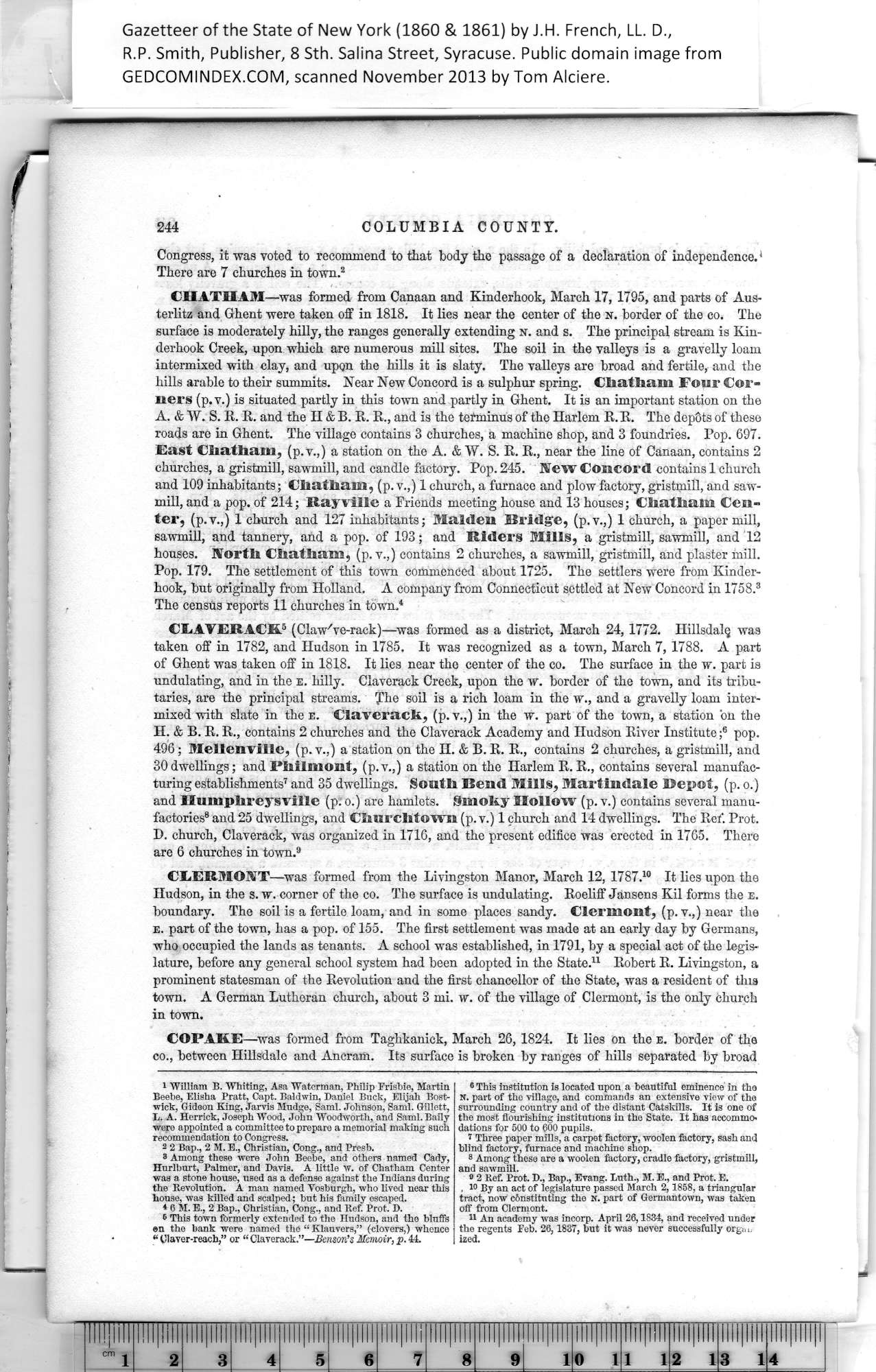|
244 COLUMBIA COUNTY.
Congress, it was voted to recommend to that body the passage of a declaration of independence.1
There are 7 churches in town.2
CHATHAM—was formed from Canaan and Kinderhook, March 17, 1795, and parts of Aus-
terlitz and Ghent were taken off in 1818. It lies near the center of the n. border of the co. The
surface is moderately hilly, the ranges generally extending n. and s. The principal stream is Kin¬
derhook Creek, upon which are numerous mill sites. The soil in the valleys is a gravelly loam
intermixed with clay, and upon the hills it is slaty. The valleys are broad and fertile, and the
hills arable to their summits. Near New Concord is a sulphur spring. Chatham Four Cor¬
ners (p.v.) is situated partly in this town and partly in Ghent. It is an important station on the
A. & W. S. B. B. and the H & B. B. B., and is the terminus of the Harlem B. B. The depbts of these
roads are in Ghent. The village contains 3 churches, a machine shop, and 3 foundries. Pop. 697.
East Chatham, (p.v.,) a station on the A. & W. S. B. B., near the line of Canaan, contains 2
churches, a gristmill, sawmill, and candle factory. Pop. 245. lew Concord contains 1 church
and 109 inhabitants; Chatham, (p.v.,) 1 church, a furnace and plow factory, gristmill, and saw¬
mill, and a pop. of 214; Rayville a Friends meeting house and 13 houses; Chatham Cen¬
ter, (p.v.,) 1 cburch and 127 inhabitants; Malden Bridge, (p.v.,) 1 church, a paper mill,
sawmill, and tannery, and a pop. of 193; and Riders Mills, a gristmill, sawmill, and 12
houses. North Chatham, (p.v.,) contains 2 churches, a sawmill, gristmill, and plaster mill.
Pop. 179. The settlement of this town commenced about 1725. The settlers were from Kinder¬
hook, but originally from Holland. A company from Connecticut settled at New Concord in 1758.3
The census reports 11 churches in town.4
CEAVERACK4 (Claw5 ve-rack)—was formed as a district, March 24, 1772. Ilillsdalq was
taken off in 1782, and Hudson in 1785. It was recognized as a town, March 7, 1788. A part
of Ghent was taken off in 1818. It lies near the center of the co. The surface in the w. part is
undulating, and in the e. hilly. Claverack Creek, upon the w. border of the town, and its tribu¬
taries, are the principal streams. The soil is a rich loam in the w., and a gravelly loam inter¬
mixed with slate in the e. Claverack, (p.v.,) in the w. part of the town, a station bn the
H. & B. B. B., contains 2 churches and the Claverack Academy and Hudson Biver Institute ;6 pop.
496; Mellenville, (p.v.,) a station on the H. & B. B. B., contains 2 churches, a gristmill, and
30dwellings; and Philmont, (p.v.,) a station on the Harlem B. B., contains several manufac¬
turing establishments7 and 35 dwellings. South Bend Mills, Martindale Depot, (p. o.)
and Humphreysville (p. o.) are hamlets. Smoky Hollow (p. v.) contains several manu¬
factories6 and25 dwellings, and Churchtown (p.v.) 1 church and 14 dwellings. The Befi. Prot.
D. church, Claverack, was organized in 1716, and the present edifice was erected in 1765. There
are 6 churches in town.9
CEERMONT—was formed from the Livingston Manor, March 12, 1787.10 It lies upon the
Hudson, in the s. w. corner of the co. The surface is undulating. Boeliff Jansens Kil forms the e.
boundary. The soil is a fertile loam, and in some places sandy. Clermont, (p.v.,) near the
e. part of the town, has a pop. of 155. The first settlement was made at an early day by Germans,
who occupied the lands as tenants. A school was established, in 1791, by a special act of the legis¬
lature, before any general school system had been adopted in the State.11 Bobert B. Livingston, a
prominent statesman of the Bevolution and the first chancellor of the State, was a resident of this
town. A German Lutheran church, about 3 mi. w. of the village of Clermont, is the only church
in town.
COPAKE—was formed from Taghkanick, March 26,1824. It lies on the e. border of the
co., between Hillsdale and Ancram. Its surface is broken by ranges of hills separated by broad
|
6 This institution is located upon a beautiful eminence in the
N. part of the village, and commands an extensive view of the
surrounding country and of the distant Catskills. It is one of
the most flourishing institutions in the State. It has accommo.
dations for 500 to 600 pupils.
t Three paper mills, a carpet factory, woolen factory, sash and
blind factory, furnace and machine shop.
8 Among these are a woolen factory, cradle factory, gristmill,
and sawmill.
o 2 Ref. Prot. D., Bap., Evang. Luth., M. E., and Prot. E.
, 13 By an act of legislature passed March 2,1858, a triangular
tract, now constituting the N. part of Germantown, was taken
off from Clermont.
U An academy was incorp. April 26,1834, and received under
the regents Feb. 26,1837, hut it was never successfully orgv.i.
ized. |
1
William B. Whiting, Asa Waterman, Philip Frisbie, Martin
Beebe, Elisha Pratt, Capt. Baldwin, Daniel Buck, Elijah Bost-
wick, Gideon King, Jarvis Mudge, Sami. Johnson, Sami. Gillett,
L. A. Herrick, Joseph Wood, John Woodworth, and Sami. Baily
were appointed a committee to prepare a memorial making such
recommendation to Congress.
2
2 Bap., 2 M. E., Christian, Cong., and Presb.
3
Among these were John Beebe, and others named Cady,
4
* 6 M. E., 2 Bap., Christian, Cong., and Ref. Prot. D.
5
en the bank were named the “ Klauvers,” (clovers,) whence
6
“ Ulaver-reacb,” or “Claverack.”—Benson’s Memoir, p. 44.
|
